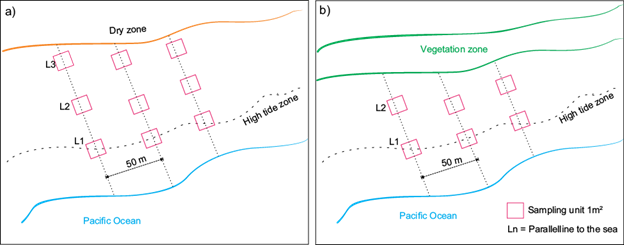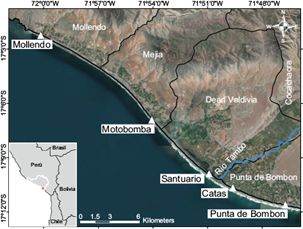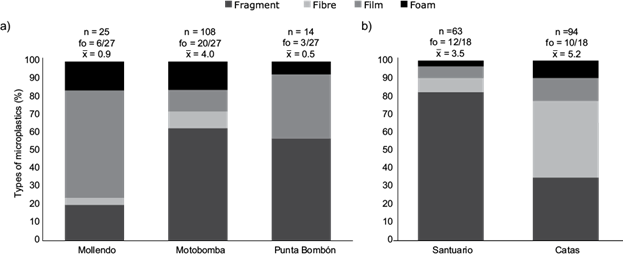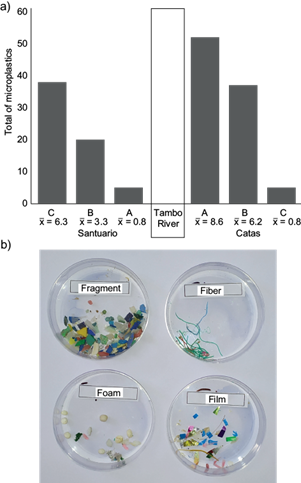INTRODUCTION
Plastic manufacturing started around 1930, achieving a significant increase in its production rate from around 1.5 to 368 million tons by 2019 (PE 2020), which is a consequence of its high demand due to its multiple properties and advantages (Masiá et al. 2019). It has been estimated that a high percentage (~ 4%) of this plastic production ends up in the oceans where, transported by the ocean currents, some is then deposited on shorelines around the world (Martinez et al. 2009, Andrady 2011, UNEP 2021). Therefore, along with its production, the accumulation rate of plastics in the oceans is also increasing every year (Jambeck et al. 2015) which, added to its low degradation rate, allows it to remain in these environments for many years becoming a serious environmental problem. During this slow degradation process, smaller particles known as microplastics are produced principally by UV radiation and mechanical action (Rojo-Nieto and Montoto 2017).
These microplastics include all those plastic particles smaller than 5 mm in size (Crawford and Quinn 2017), which can be found in a wide variety of habitats around the world, even inside the human body (Leslie et al. 2022). It is estimated that currently around 4.8 to 12.7 million tons of microplastics are discharged into the oceans every year, and this quantity is increasing over time (Jambeck et al. 2015), expected to reach around 13% of the total plastics production by 2040 (UNEP 2021). Among its environmental problems, microplastics represent a potential risk for living organisms affecting planktonic organisms, invertebrates, and vertebrates, mainly birds, mammals, and fish (Wright et al. 2013, Clark et al. 2016, Yu et al. 2018). The above is because they can be distributed throughout the trophic webs at different levels of the food chain, including human beings (Nadeeka et al. 2017, Rist et al. 2018, Cho et al. 2019). Recent studies have shown that microplastics are accumulating on beaches worldwide (Andrady 2011, Browne et al. 2011, Isobe et al. 2015, Nel and Froneman 2015, Kunz et al. 2016, Wessel et al. 2016, Peng et al. 2020, Urban-Malinga et al. 2020), including Arctic areas (Erikson et al. 2013, Fang et al. 2018). In South America, some research on microplastics have been developed during the last few years (Kutralam-Muniasamy et al. 2020), where the main scope was ecological, covering identification, spatial and temporal distribution, as well as the sources of the microplastics and consequences of their presence (Ivar do Sul and Costa 2007, Rezania et al. 2018, Kutralam-Muniasamy et al. 2020). In Peru, few investigations have been carried out, especially in beach environments, and most of them are related to ingestion by animals and freshwater environments (Purca and Henostroza 2017, Iannacone et al. 2019, de la Torre et al. 2020, Perez-Venegas et al. 2020, Valencia-Velasco et al. 2020, de la Torre et al. 2021).
Therefore, it is essential to complement this information to provide a research baseline on the types of microplastics present on the sandy beaches and their accumulation in different types of ecosystems, especially within the local and national reality, establishing possible causes of their presence, effects, and actions to be implemented for their reduction. For that reason, this study aimed to evaluate the presence and type (morphology) of microplastics present on the sandy beaches (Mollendo, Motobomba, Santuario, Catas, and Punta de Bombon) of Islay province, located in the department of Arequipa, southern Peru. It also included the evaluation of the effect of the Tambo River estuary dynamic in the surrounding beaches on the abundance of microplastics, as this area is vital for migratory birds to feed and rest.
MATERIALS AND METHODS
Study area
The study was conducted during October and November 2018 on five sandy beaches of the coastal area of Islay, department of Arequipa, in southern Peru, one of the main coastal areas in the south of this country. Currently, the population around these beaches is estimated at 52 000 inhabitants (INEI 2018), whereas, during the summer, more than 150 000 visitors can reach. The study covered the beaches located in the districts of Mollendo, Mejía, Dean Valdivia, and Punta de Bombón (Fig. 1). The selected beaches were Mollendo (17º2’15.41” S / 72º0’7.84” W), Motobomba (17º7’0.75” S / 71º53’56.41” W), Punta de Bombón (17º11’38.62” S / 71º46’43.38” W), Santuario (17º9’56.03 “S/ 71º50’53.77” W) and Catas (17º10’34.16” S / 71º49’49.99” W). The last two beaches were analyzed separately to determine if the Tambo River estuary influenced the presence of microplastics.
Sampling design on sandy beaches
Three sampling stations were selected on each beach for Mollendo, Motobomba and Punta de Bombón beaches following the methodology described by Losh (2015). In each station three transects (distance of 50 m between transects) perpendicular to the coastline were established. In each transect, three quadrants made of polyvinyl chloride (PVC) of 1 m2 were deployed making a total of nine quadrants per sampling station (Fig. 2a), therefore 27 quadrants per beach. A sample of sand was collected up to a depth of 5 cm per each quadrant. In order to keep independent evaluated areas within each beach, every station was 1 km away from each other.

Fig. 2 Methodology used at each sampling station, showing the quadrant installation layout in the area to be evaluated (adapted and modified from Losh 2015) for sandy beaches in the province of Islay, Islay province. Arequipa (a) for independent beaches (Mollendo, Motobomba, Punta de Bombón) and (b) beaches influenced by the Tambo River estuary (Santuario and Catas).
In the case of Santuario and Catas beaches, which could be affected by Tambo River discharge, the methodology was modified to include six stations, three for each side of the river’s mouth and separated 1 km away. The letters “A,” “B,” and “C” were used to identify the stations: stations “A” were the closest one to the river mouth, and stations “C” were the farthest one from the river mouth. Only six quadrants per sampling station were deployed due to the narrowness of the evaluated area (Fig. 2b) caused by vegetation in the upper zone (Verlander and Mocogni 1999). The delimitation of the stations covered the area from the high tide line towards the upper part, known as the dry zone, avoiding areas of abnormal concentrations of multigenerational tidal accumulation lines (de Carvalho and Baptista-Neto 2016).
Sample processing and statistical analysis
Each sample was first sieved through a 5 mm mesh sieve and then through a 1 mm mesh sieve (de Carvalho and Baptista-Neto 2016). The material remaining from the 1 mm sieve was stored, avoiding any pressure that could fragment the collected particles, and labeled for further processing in the laboratory. The samples obtained were separated individually by beach, site and sampling quadrant. Then they were classified and counted with a stereomicroscope following the methodology recommended in the literature (Andrady 2011, Hidalgo-Ruz et al. 2012). Other separation methods were not applied since the microplastics could be fragmented increasing the number of particles that could cause an overestimation in the final count. In some cases, a hot needle was used to make sure that the particle was in fact plastic. The microplastics were classified into five types, following the general classification proposed in Crawford and Quinn (2017), such as pellets, fragments, fibers, films, and foams. The obtained data were used to estimate the total amount, frequency, and density of microplastics on the beaches. The Mood’s median test was used to evaluate the statistical difference in the number of microplastics found between the beaches, where the normality of the data was verified previously by the Shapiro-Wilk test. All statistical analyses were conducted using RStudio (RST 2020).
RESULTS AND DISCUSSION
Abundance and frequency of microplastics on independent beaches
One hundred forty-seven microplastic particles (MP) were found on the beaches that were assessed as independent (Mollendo, Motobomba, Punta de Bombón). Results showed significant differences (Chi-square: χ2= 24.7, df= 2, P < 0.01). Motobomba Beach had the highest number of MP (108 pieces, X̅ = 4.0 part/m2), as well as a higher frequency of occurrence of MP (20 out of 27 samples). On the other hand, Mollendo Beach and Punta de Bombon showed a low frequency of particle occurrence (Fig. 3a). For these two beaches, the range of MP was from 0 to 21 part/m2 and a mean value of 1.81 part/m2, showing relatively low pollution values. These results are similar to those evaluated by Purca and Henostroza (2017) in the sandy beaches of central Peru (Albufera de Medio Mundo, Vesique, Costa Azul, and El Chaco), which present pretty higher values of MP per square meter (range 4 - 463 part/m2), especially the “Costa Azul” (Lima). Other beaches evaluated in Lima (de la Torre et al. 2020, Petrel et al. 2020) showed higher values of microplastics found in the central (16.6 - 489 part/m2) and southern beaches of Lima (136 - 394 part/m2). Regarding the type of MP found on these beaches, the presence of fragments, film, fibers, and foams was observed. However, no pellets in either of the three beaches, which is remarkable since in many studies conducted on coastal sandy areas, pellets were the dominant type of MP (Hidalgo-Ruz et al. 2012, de Carvalho and Baptista 2016, Kunz et al. 2016, Abayomi et al. 2017, de la Torre et al. 2020). The results of the present study could be explained by the absence of industries producing plastic products in Arequipa or Moquegua, which could discharge pellets to the Tambo River basin. However, the presence of these MP is confirmed for sandy beaches in Lima (Peru) by Purca and Henostroza (2017) and de la Torre et al. (2020), but in lower proportion compared to the other types of MP. Among all the types of MP, fragments predominated with an average of 46.7% per beach, except for Mollendo Beach, where the predominant type was film (60.0%), the second most abundant MP on the other beaches with an average of 35.9%. In the case of fibers, the average for each beach was 4.4% (Fig. 3a). The results obtained bear out the predominance of fragments following other research conducted on sandy beaches in South America (Hidalgo-Ruz and Thiel 2013, de Carvalho and Baptista 2016, Purca and Henostroza 2017) and other parts of the world (Corcoran et al. 2009, Karthik et al. 2018, Rezania et al. 2018). Likewise, within the fragment type, it was possible to find hard plastics that are also common in other Peruvian reports (Purca and Henostroza 2017, de la Torre et al. 2020). Moreover, foams were also present in the three studied beaches with a higher abundance than fibers. In the characterization, it was found that most of the particles corresponded to expanded polystyrene (EPS), which could come from widely used packaging to carry food, especially by tourists during the summer season. These results would agree with Browne et al. (2010) since most of the plastics found in beaches such as those ones found in Islay would come from garbage and candy bags and even construction elements. The latter can be incorporated as MP by photodegradation and abrasion processes to sandy beaches.
Distribution of microplastics on beaches adjacent to the Tambo River
No statistical differences were found between the beaches influenced by the Tambo River estuary (t = 0.75, df = 24.0, P = 0.46). A total of 157 MP were reported, with an interval from 0 to 32 part/m2 and a mean of 4.36 part/m2, which is also reported by other investigations in estuarine or river mouth areas with higher values of particles per square meter (Brown et al. 2010, Wessel et al. 2016, Gray et al. 2018). For Catas Beach, a higher number of total MP (94 particles, X̅ = 5.2 part/m2) were found compared to Santuario Beach (63 particles, X̅ = 3.5 part/m2; Fig. 3b), presenting also higher values than the beaches evaluated independently (Mollendo and Punta de Bombón), and even higher than Motobomba Beach, despite the lower sampling effort on the beaches adjacent to the Tambo River. The greater quantity and frequency of MP on these beaches could be explained by the possible contribution of the Tambo River as a source of microplastics input from upstream areas and as the main factor in the spatial distribution of MP on the adjacent coasts. It is known that rivers drag debris (millions of tons per year), including MP (Fendall and Sewell 2009, Browne et al. 2011, Rech et al. 2014, Yu et al. 2018). Presumably, the concentration of MP will increase over time for all these areas since there are neither adequate water treatment plants (WWTP) in the area nor any system that includes a plastic particle filtering system (Andrady 2011, Browne et al. 2011). In addition, seasonal variations, such as in the intensity of wind and rain during summer, could also temporarily increase the concentration of microplastics (Lebreton et al. 2017, Lozoya et al. 2021). Furthermore, the studied beaches would correspond to the dissipative type, which tends to present a greater abundance of microplastics (Lozoya et al. 2021, Tsukada et al. 2021) due to the morphodynamics (extension, slope, granulometry) that facilitate the deposition of these plastic particles.
Regarding the type of MP, fragments were also the most abundant in both beaches, especially in Santuario Beach, where about 80% of the particles found corresponded to this type. In contrast, for Catas Beach, fragments and fibers were equally dominant, with about 30% each (Fig. 3b). This tendency is similar to that in an estuary of the Cantabrian coast (Masiá et al. 2019) and India (Karthik et al. 2018), in the latter, it was found that the proportion of fragments was usually higher (~ 10% to 20%) in areas without influence of the river, or further away from it.
No significant differences were found regarding the distribution of microplastics in the sampling stations distant from the river mouth (Chi-square: χ2= 7.60, df = 5, P = 0.180). A large amount of MP was found in the stations near Catas Beach (stations A and B), so the most significant accumulation of MP would happen between the first 2 km from the mouth of the Tambo River (4 - 35 particles) in a southerly direction. Regarding the stations at Santuario Beach, a more significant number of MP were found at stations B and C, with almost no MP in the sector closest to the river (Fig. 4a). As previously mentioned, for beaches influenced by the wind, this is usually the primary variable in the distribution of MP as they will settle in the direction of the wind (Kim et al. 2015, Karthik et al. 2018). In the case of Islay, the predominance of the wind comes from the South-East. The above, combined with the coastal currents of the area (Jambeck et al. 2015), would be a more significant settlement of microplastics in the Catas sector and drag the particles farther away from Santuario Beach. The absence of differences in MP concentration at different distances from the mouth of Tambo River corroborates the findings of other research (Browne et al. 2010, Wessel et al. 2016, Gray et al. 2018) in estuarine areas and bays (such as USA and England), and in beaches or areas adjacent to rivers, where the effect and distribution of MP is usually similar; however, this can change quickly due to the great dynamics of these systems, that can be modified even in different seasons of the year (Wessel et al. 2016). Likewise, this study represents the first approach to MP as contaminants on sandy beaches in the southwestern sector of Peru during the last few years. It is among the few related to the influence of rivers on the potential effect of MP distribution and accumulation. We also highlight the need for monitoring the interaction with the trophic components associated with these sandy systems to establish management perspectives, particularly with birds, especially migratory species, where this evaluated area represents a critical zone for their life cycle development.
CONCLUSIONS
This research demonstrates the existence of microplastic particles along the sandy beaches of Islay (Arequipa, Peru). The particles corresponded to the types: fragments, film, fibers, and foams, with the absence of pellets in all the evaluated samples.
The number of particles found on the sandy beaches of Islay, for beaches evaluated independently, corresponded to an interval of 0 - 21 part/m2 with a mean of 1.81 part/m2; for Mollendo Beach, the predominant type of PM was film (60%), while for Motobomba and Punta Bombón beaches fragments were the predominant type with a 63.0% and 57.1% predominance, respectively.
Besides, for beaches influenced by the Tambo River, the interval of MP found was 0 - 32 part/m2 and a mean of 4.36 part/m2; for Santuario Beach, the predominant type was fragments with 83%, and for Catas Beach the predominance was fibers (43%).











 nova página do texto(beta)
nova página do texto(beta)





